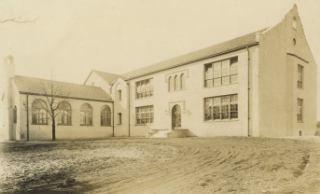✕
Our journey: The evolution of the Burroughs campus

Enrollment: 75 in 1923 & 272 by 1929
From Concept to Opening Day
- In March 1922, an Executive Committee headed by Mrs. David O’Neil and Mr. Louis Egan took charge of the plans for what would become John Burroughs School.
- In November 1922, the John Burroughs School Association was established led by Mr. Louis Egan, President, Mrs. Hugh McKittrick Jones, First Vice-President, Mr. C.R.D. Meier, Second Vice-President, Mr. Fred B. Eiseman, Treasurer, and Mrs. George Gellhorn, Secretary. Members included: Mr. Eugene Angert, Mr. Willard W. Boyd, Jr., Mrs. Ernest W. Stix, Mr. J. Lionberger Davis, Mrs. Joseph W. Lewis, Mr. G. Riesmeyer, Jr., and, later on, Mr. Benjamin Gratz and Dr. and Mrs. Evarts Graham.
- Several members of the John Burroughs School Association personally guaranteed the loan to acquire 17.5 acres for $35,000 to create the campus for Burroughs.
- A sum of $500,000 was raised to operate Burroughs for its first five years. The money was raised through mortgage bonds, donations, and certificates of membership in the John Burroughs School Association at $1,000 each; 85 memberships were initially pledged, ranging from $1,000 to $12,500 ($17,000 - $200,000 in today’s dollars).
- The architecture firm of LaBeaume and Klein was engaged to design the first building (rededicated as the Brauer Building in 1995). The Spanish style of architecture was selected because the school’s Founders thought that “St. Louis had always been the gateway to the Southwest.”
Program Highlights
- Mr. Wilford M. Aikin was selected to be the first head of school. He was very progressive and had recently relinquished his position as professor of education at the University of California to direct the Scarborough School in Briarcliff Manor, New York, from 1918 - 1922. Aikin arrived in St. Louis in January 1923 and immediately set to work with the “Incorporators” (lead by Louis H. Egan) to plan the Burroughs campus, hire teachers, and enroll our first students.
- The Review was launched in the school’s first year and was published in 1924. This bound book offered an outlet for student writing, including poetry and short stories authored by Martha Gellhorn ’26, Emily Lewis ’26, Elizabeth Stix ’26, William Stix ’28, and many others. The Review was overseen by Mr. Howard Seely, who, according to his successor Dr. Mark Neville, was “the greatest English teacher who ever stood on two feet.”
- The first issue of The World was published in 1928.
- Long before Title IX, girls sports played a central role at Burroughs, beginning with a four-year undefeated streak for the varsity field hockey team in the late 1920s. The 1929 field hockey team even compiled a 4-0 record, devastating its opponents 35 goals to one.
Campus Highlights
- On March 24, 1923, the future home of Burroughs was formally dedicated and a flag raising ceremony was held on the property with Mr. Aikin presiding.
- On October 2, 1923, John Burroughs School opened its doors with 75 students and a faculty of 10.
- On October 12, 1923, the main building was dedicated and the cornerstone was laid.
- Enrollment more than tripled between 1923 and 1929. As a result, additional classrooms, science labs, music and art rooms, and a library were built.
- In December 1929, a workshop theater with seating for 135 was built almost entirely by Burroughs students. It was dubbed “Slabsides” in honor of naturalist John Burroughs’ wilderness home. It opened in January 1930.